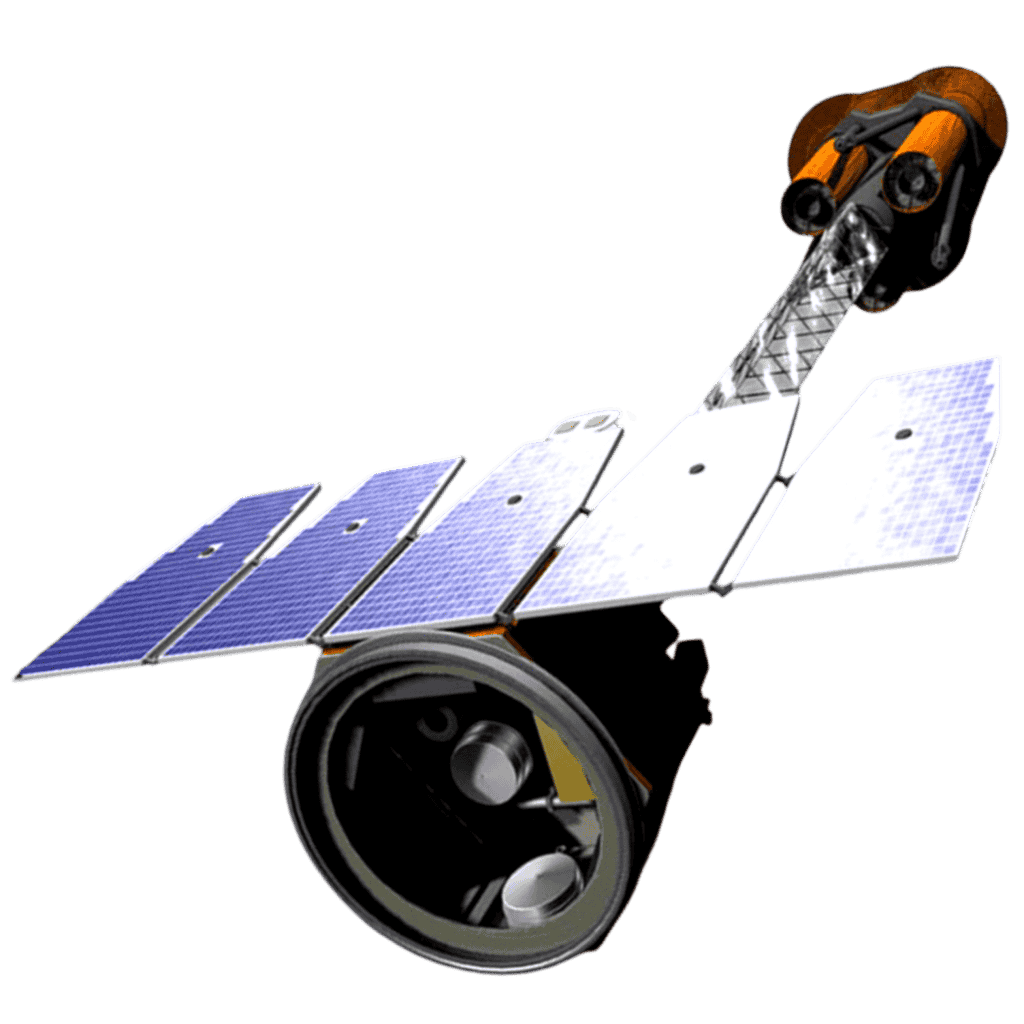Imaging X-ray Polarimetry Explorer
Polarimetry Pioneer
First telescope dedicated to X-ray polarimetry

USPs
- Measures X-ray polarization from cosmic sources
- Studies black holes and neutron stars
- Provides unique insights into high-energy processes
- First dedicated X-ray polarimetry mission
- Uses three telescopes for simultaneous observations
- Reveals geometry and magnetic fields of extreme objects
Major Milestones
- 2021-12-09: Launched aboard a SpaceX Falcon 9 rocket from NASA's Kennedy Space Center, marking the start of its mission to measure X-ray polarization from cosmic sources.
- 2021-12-10: Deployed its solar arrays and began commissioning, initiating the process to extend its 4-meter boom for optical alignment.
- 2021-12-17: Extended its deployable boom, achieving the 4-meter focal length required for its three X-ray telescopes.
- 2022-01-11: Released its first-light image of Cassiopeia A, a supernova remnant, demonstrating its polarization-sensitive imaging capabilities.
- 2022-03-22: Returned initial data from extreme cosmic objects, detecting polarized X-rays from sources like the Crab Nebula, neutron stars, and magnetars.
- 2023-06-26: Successfully resumed science operations after a telemetry interruption, following a spacecraft reset, ensuring mission continuity.
- 2023-07-01: Confirmed normal science operations resumed, allowing continued observation of high-energy astrophysical sources.
- 2024-04-03: Resumed normal science operations after another avionics reset, maintaining data collection from celestial targets.
- 2024-10-17: Provided new insights into the shape of a black hole corona, revealing its structure through polarization data from accreting black holes.
- 2025-07-16: Reported discoveries on pulsar wind interactions in rare neutron star systems, enhancing understanding of high-energy cosmic processes.
Cosmic Portrait
IXPE: Unveiling X-ray Secrets
Imaging X-ray Polarimetry Explorer (IXPE), a groundbreaking mission launched by NASA in December 2021, is the first space telescope specifically designed to measure the polarization of X-rays from celestial sources. Unlike traditional X-ray observatories, IXPE doesn’t just detect the intensity and energy of X-rays—it also reveals the direction in which these high-energy waves vibrate, unlocking a previously invisible dimension of the universe.
- Scientific Mission: IXPE focuses on some of the most extreme and enigmatic objects in the cosmos, including black holes, neutron stars, magnetars, and pulsars. By studying the polarization patterns of X-rays emitted by these sources, the telescope provides insight into the magnetic fields, structure, and emission mechanisms in these high-energy environments.
- Orbit & Operations: Positioned in a stable low-Earth orbit (LEO) at an altitude of about 600 kilometers, IXPE circles the planet every 90 minutes. This orbit offers the ideal combination of high-resolution data collection and communication with ground stations. Its consistent exposure to cosmic sources and shielding from Earth's radiation belts enhance its sensitivity and operational efficiency.
- Revolutionary Technology: At the heart of IXPE are its three identical telescopes equipped with gas pixel detectors. These detectors can precisely measure the angle of incoming X-ray photons, allowing scientists to reconstruct the polarization signature. This technology represents a significant leap from earlier missions, enabling IXPE to achieve unprecedented accuracy in mapping X-ray polarization.
- Targeted Observations: Since launch, IXPE has observed a variety of exotic objects. Notable targets include the supernova remnant Cassiopeia A, the Crab Pulsar, active galactic nuclei, and even the accretion disks of stellar-mass black holes. Each observation adds new clues to the nature of compact objects and the fundamental forces at work near event horizons and neutron star surfaces.
Scientific Impact and Legacy
As of 2025, IXPE has significantly advanced our understanding of how matter behaves under extreme conditions—such as intense gravity and magnetic fields. For example, polarization data from black hole binaries has helped distinguish between competing models of X-ray emission from accretion disks. Similarly, studies of magnetars have revealed complex magnetic geometries that weren’t detectable with previous instruments.
IXPE’s success lies in its ability to provide data that complements other X-ray observatories like NASA’s Chandra X-ray Observatory and ESA’s XMM-Newton. Where these missions provide spatial and spectral information, IXPE adds polarization to the mix, completing the picture of high-energy astrophysical processes.
Looking ahead, IXPE is expected to continue delivering high-impact science throughout its mission duration. Its findings will refine models of relativistic jets, probe the interior structure of neutron stars, and help test theories of quantum electrodynamics in strong-field regimes.
IXPE is a cosmic detective, decoding the hidden properties of the universe’s most extreme objects.
With its novel capabilities and growing catalog of observations, the Imaging X-ray Polarimetry Explorer is transforming our view of the high-energy universe. It’s not just observing—it’s interpreting, revealing, and revolutionizing our understanding of phenomena that lie at the frontier of modern astrophysics.
Fun Fact
IXPE can reveal the spin and magnetic fields of black holes!